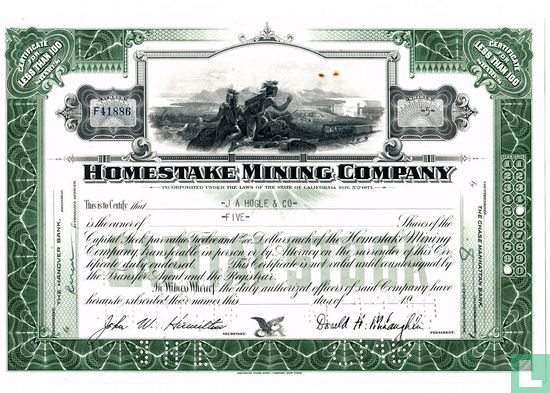Catalogue information
Signatures facsimile. Piece by name. Depreciation by perforation. Officially incorporated in California on November 5th, 1877, the Homestake Mining Company's Homestake Gold Mine was one of the early enterprises associated with the Gold Rush of 1876 in the northern Black Hills of what was then Dakota Territory. The mining community of Deadwood was the center of the gold fever, with tents, sawmills, log houses and saloons springing up seemingly overnight. But the real action would happen three miles away "over the hill" where brothers Fred and Moses Manual and their partner Hank Harney located their Homestake claim on April 9, 1876. Moses liked what he saw in an outcropping of a vein of ore, referred to as a lead and pronounced "sorrow." Soon more prospectors materialized, and no time was lost in selecting a site for a new town. On July 10th work began on laying out the town lots, and that work was completed the next day. Miners were offered the lots, 50 x 100 feet, but were required to build on the lots in 60 days or forfeit them. That spurred many on to build on the front half and then sell the back half. Progress came quickly. Telegraph service began December 1st and by early 1877 four hotels, a grocery store, saloon, bakery and butcher shop were up and running. In June 1877 George Hearst, who had earlier sent an agent to offer a bond to owners of the Homestake claim, bought the four and one half acre claim for $ 70,000. No stranger to mining, Hearst had mining interests in Missouri, California during its gold rush, Nevada, Utah, and Montana. He later represented the State of California in the United States Senate. He and his wife Phoebe had one son, William Randolph Hearst, who, rather than continue in his father's footsteps in the mining businesses, chose to manage his father's newspaper, the San Francisco Examiner. William became a publishing magnate and was a pioneer in the radio and television industries. With a population of 8,392 in 1910, Lead was the second largest community in South Dakota. The employment opportunities for not only miners, but also laborers and mechanics were excellent. After George Hearst's death in 1891, his widow Phoebe made substantial contributions to the educational and cultural life of Lead. She was responsible for the establishment of the first kindergarten in the entire West. In addition, she arranged for the Homestake Mining Company Homestake Opera House and Recreation Building to be constructed as gifts to the community from the company. Tickets had to be purchased for events in the Opera House, but use of the swimming pool, bowling alley, meeting rooms and library was free. Throughout the decades to come the City of Lead and the Homestake Mine were confronted with challenges ranging from an epidemic of Spanish influenza, nearby forest fires and even a fire in the mine, which was extinguished by a deliberate flooding of the mine and subsequent dewatering with no ill effects to the mine or its equipment. But on the whole, the city and its residents prospered as a result of the mine. In the early 1930s, as the rest of the nation suffered economic hardship throughout the Great Depression, the management of Homestake set a shorter work week with an increase in wages, and provided end of year bonuses to workers. During World War II, gold mining operations were suspended by order of the War Production Board. The young men of the city joined the armed forces, moved to locations where copper mines were operating or worked in airplane factories. The older men who remained in what was by then an almost deserted town worked in the Homestake foundry or machine shop producing goods needed for the war effort, including parts for airplanes, wrenches and hand grenades. The following decades saw modernization of mining techniques and procedures, including the advent of computerization to the Homestake Mine. The workers voted in 1966 to be represented by the United Steel Workers union. In September of 2000 a Homestake Gold Mine spokesman announced that the mine would close. In December of 2001, the Homestake Gold Mine finally shut down after more than 125 years of continuous operation.
This text has been translated automatically from Dutch
Click here for the original text

